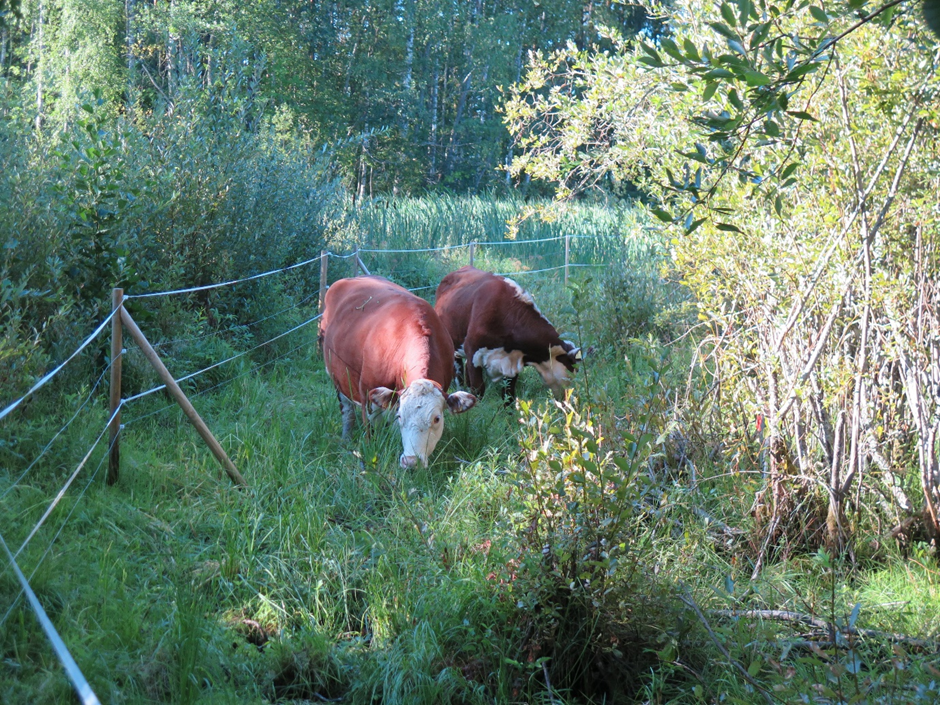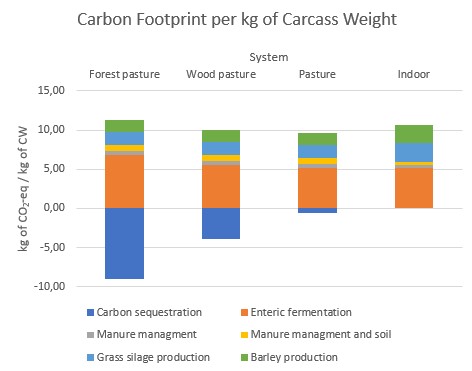Food is a vital part of everyday life and what we eat has a big impact on the environment. Emission from the livestock sector are a big concern as they represent around 12% of all human induced greenhouse gas emissions, and ruminants are responsible for 80% of these emissions (Statistics Finland 2019). Different studies suggest that consumers should switch their dietary habits and consume less animal products, in order to reduce our environmental impact.
Ruminants include, for example cattle, all domesticated and wild goats and sheep, and more. They are a valuable resource for mankind since the earliest human society. Ruminants are able to convert roughage feed (like grass, hay, food by-products not suitable for human consumption) into edible food product with high nutritive value proteins and microelements essential for our body (milk, meat). Moreover, ruminants can thrive well on poor productive land areas unsuitable for crop cultivation.

Fig.1 Forest grazing in the Höytiäinen canal estuary nature protection area, Joensuu, Finland. Photo: Michael den Herder
For these reasons reducing the number of animals is not the only solution, but other sustainable strategies must be adopted in order to reduce greenhouse gas emission from the ruminant sector. Over the last couple of years, silvopastoral systems received increasing attention. Silvopastoral systems have traditionally been an important element of rural landscapes, combining forests and cattle on the same area. In Finland, over the last decades, silvopastoral systems have been abandoned or converted to arable land or commercial forests. New studies suggest that silvopastures have potential for sustainable intensification that allow to mitigate greenhouse gas emission from livestock through carbon sequestration of trees in the system, while not adding emissions by producing additional feed which is needed when cattle, for example, are kept indoors. Silvopastures don’t pose a conflict between food and feed production.
A greenhouse gas emission assessment was made in order to compare four different beef cattle production systems in Finland: Forest pasture, wood pasture, pasture and indoor system. The data used in the assessment were taken from scientific publications and calculations in accordance with IPCC guidelines (2006). In Finland, cattle graze outdoors only for 3 to 5 months in a year, depending on the location. During these months, no concentrate feed is given to the animals because they can browse forest understory, grass, shrubs and young deciduous trees. In wintertime is necessary to feed the animals with forage and feed produced on-farm or imported from other countries.

Fig. 2 Carbon footprint per kg of carcass weight in four beef cattle production systems in Finland: Forest pasture, wood pasture, open pasture and indoor production
Emissions from enteric fermentation, which is the digestive process for cattle, significantly contribute to the total greenhouse gas emissions, especially in the forest pasture system due to the large amount of rough feed, such as forest understory, eaten by the animal (Figure 1, Table 1). When animal eat feed and forage with a high content of fibre, methane is released as a by-product of fermentation of fibre in the rumen.
Emissions from feed production (Figure 1, Table 1), in this case grass-silage and barley, are also significant because they include emissions from agronomic practices such as fertilization and ploughing. Those inputs have a great impact on the environment, not just in terms of emission but also on biodiversity, eutrophication of water, use of natural resources and so on. If during the summer time no feed is given to cattle, it would be possible to reduce their use and consequently the environmental impact of feed production decreases.

Table 1. Global warming potential per kilogram of carcass weight in four beef cattle production systems in Finland: Forest pasture, wood pasture, open pasture and indoor production.
The carbon footprint resulting from each system ranged from 2.19 kg CO2-eq/ kg carcass weight (CW) in the forest pasture to 10.60 kg CO2 eq/ kg CW in the indoor system (Figure 1, Table 1). In the forest pasture, wood pasture and open pasture systems there is a component of carbon sequestration. This uptake is able to balance most of the emissions generated from the beef cattle production system, especially in the silvopastoral systems where trees are present. In the forest pasture, meat production was getting close to carbon neutrality. Carbon sequestration is not the only ecosystem service that is provided by silvopastoral systems: soil enrichment, biodiversity conservation and improvement of soil and water quality are also important aspects to consider.
Farmers might be sceptical to implement silvopastoral systems because animal performance might decrease due to the lower feed digestibility compared with the conventional feed ration used in conventional system. However, silvopastoral system allowed a diversification of income because meat is not the only product. For example, in the forest pasture it is possible to sell wood products. In the near future, selling carbon credits on the carbon market may become a possible source of income.
In the scientific literature exist a lot of studies on the climate mitigation potential of agroforestry, but studies in Finland on this topic are so far completely lacking. Best management practices need to be adopted in order to balance the herbage and grass production, animal performance and optimize carbon sequestration. More research is needed on carbon storage and sequestration in different grazing systems as forest and wood pasture grazing hold a large potential for sustainable and carbon neutral meat production.











